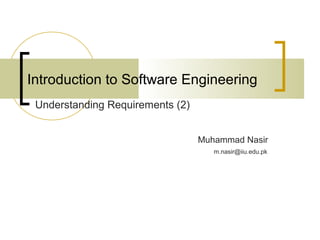
Lecture 10 understanding requirements (2)
- 1. Introduction to Software Engineering Muhammad Nasir Understanding Requirements (2) m.nasir@iiu.edu.pk
- 2. Agenda Requirement Elicitation Collaborative Requirement Gathering Quality Function Deployment Elicitation Work Product User Scenario
- 3. Eliciting Requirement Approach for eliciting requirement: Collaborative Requirement Gathering Quality Function Deployment User Scenarios Elicitation Work Products
- 4. Collaborative Requirement Gathering Meetings are attended by all interested stakeholders. Rules established for preparation and participation. Agenda should be formal enough to cover all important points, but informal enough to encourage the free flow of ideas. A facilitator controls the meeting. A definition mechanism (blackboard, Wall Stickers, etc.) is used.
- 5. Collaborative Requirement Gathering During the meeting: The problem is identified. Elements of the solution are proposed. Different approaches are negotiated. A preliminary set of solution requirements are obtained. The atmosphere is collaborative and non-threatening.
- 6. Collaborative requirement gathering (contd.) In initial meeting, distribute “Product request” (defined by stakeholder) to all attendee. Based on product request, each attendee is asked to make List of objects (Internal or external system objects) List of services (Processes or functions) List of constraints ( cost, size, business rules) and performance criteria( speed, accuracy) are developed.
- 7. Collaborative requirement gathering (Contd.) Collect lists from everyone and combined. Combined list eliminates redundant entries, add new ideas but does not delete anything. Objective is to develop a consensus list in each topic area (objects, services, constraints and performance).
- 8. Collaborative requirement gathering (Contd.) Based on lists, team is divided into smaller sub-teams : each works to develop mini-specification for one or more entries on each of the lists. Each sub-team the presents its mini-specification to all attendees for discussion. Addition, deletion and further elaboration are made. Now each team makes a list of validation criteria for the product and present to team. Finally, one or more participants is assigned the task of writing a complete draft specification.
- 9. Quality Function Deployment “It is a technique that translate the needs of the customer into technical requirement for software”. Concentrates on maximizing customer satisfaction. QFD emphasizes – what is valuable to the customer and then deploys these values throughout the engineering process.
- 10. Quality Function Deployment QFD Indentifies three types of requirement: 1. Normal Requirements – reflect objectives and goals stated for product. If requirement are present in final products, customer is satisfied. Examples of normal requirements might be requested types of graphical displays, specific system functions, and defined levels of performance.
- 11. Quality Function Deployment 2. Expected Requirements – customer does not explicitly state them. Customer assumes it is implicitly available with the system. Examples of expected requirements are: ease of human/machine interaction, overall operational correctness and reliability, and ease of software installation.
- 12. Quality Function Deployment 3. Exciting Requirements- Features that go beyond the customer’s expectation. For example, software for a new mobile phone comes with standard features, but is coupled with a set of unexpected capabilities (e.g., multi-touch screen, visual voice mail) that delight every user of the product.
- 13. Quality Function Deployment During meeting with customer – Function deployment determines the “value” of each function required of the system. Information deployment identifies data objects and events and also tied with functions. Task deployment examines the behavior of the system. Value analysis determines the priority of requirements during these 3 deployments.
- 14. Elicitation Work Products Elicitation work product will vary depending upon the size of the system or product to be built. Statement of need and feasibility. Statement of scope. List of participants in requirements elicitation. Description of the system’s technical environment. List of requirements and associated domain constraints. List of usage scenarios. Any prototypes developed to refine requirements.
- 15. Software Prototype Prototype constructed for customer and developer assessment. In some circumstances construction of prototype is require in beginning of analysis. (To derive requirement effectively) Selecting Prototype Approach 1. Close ended (Throwaway Approach) 2. Open ended (Evolutionary Approach)
- 16. Software Prototype Close Ended – It serves as a rough demonstration of requirement. It is then discarded, and the software engineered using a different paradigm. Open Ended – uses the prototype as the first part of an analysis activity that will be continued into design and construction. The prototype of the software is the first evolution of the finished system.
- 17. The End Thanks for listening Questions would be appreciated.
